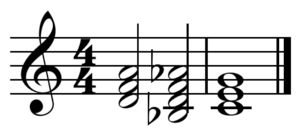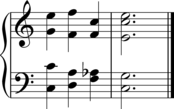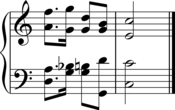Borrowed chord

A borrowed chord (also called mode mixture,[2] modal mixture,[3] substituted[4] modal interchange[2]) is a chord borrowed from the parallel key (minor or major scale with the same tonic). Borrowed chords are typically used as "color chords", providing harmonic variety through contrasting scale forms, which are major scales and the three forms of minor scales.[3] Similarly, chords may be borrowed from the parallel modes, the various modes beginning on the same tonic as a scale, for example Dorian with D major.[2] Borrowed chords are distinguished from modulation by being brief enough that the tonic is not lost or displaced, and may be considered brief or transitory modulations,[4] and may be distinguished from secondary chords,[5] as well as altered chords.[2] "The borrowed chord suggests the sound of its own mode without actually switching to that mode."[2]
In the key of C major, the regular diatonic chords are built as triads (or seventh chords) on the roots of each of the seven notes of the C major scale (the notes, C, D, E, F, G, A, and B). The chords (triads in this example) built on these scale degrees (i.e., notes) would be C major, D minor, E minor, F major, G7, A minor and B diminished. In the key of C minor, the regular diatonic chords would be C minor, D half-diminished, E♭ major, F minor, G minor (or G7, as the leading tone is often sharpened), A♭ major, B♭ major. Thus, a song in C major could "borrow" chords from C minor. For example, a simple song chord progression in C major, such as I-IV-V (C major-F major-G major) could have chords from the tonic minor added in. Thus a new chord progression could add ♭VI (A♭ major) and ♭VII (B♭ major), thus giving us I-♭VI-IV-♭VII-V or C major-A♭ major-F major-B♭ major-G major.
"Mixing of major and minor modes developed in the baroque period and was considered a part of the general style."[6] "In theory, any chord from any mode of the scale of the piece is a potential modal interchange or borrowed chord. Some are used more frequently than others, while some almost never occur."[2] Six chords borrowed from the parallel minor key are commonly found in the Baroque, Classical and Romantic eras (shown here in C major):


3 = BDFA♭) in Bach's Prelude no. 1 in C Major from The Well-Tempered Clavier, Book I, BWV 846, mm.13-15.[7]

3 = G♯BDF♮) in Mozart's Piano Sonata No. 18, K. 576, II: Adagio, mm.13-16.[7]
Diminished supertonic triad (iio) D–F–A♭ Half-diminished supertonic seventh (iiø7) D–F–A♭–C "Flat three" (♭III) E♭–G–B♭ Minor subdominant (iv) F–A♭–C "Flat six" (♭VI) A♭–C–E♭ Fully diminished leading-tone seventh (viio7) B–D–F–A♭
- The first five chords occur in the natural, harmonic, and descending melodic minor scales. The first and second chords are Aeolian. The third chord occurs in Dorian, Phrygian, and Aeolian modes. The fourth and fifth chords occur in Phrygian, Aeolian, and Locrian. The fully diminished leading-tone seventh chord is derived from the harmonic minor scale.
The following three chords are also found in Romantic era, albeit rarely:

Minor subdominant seventh (iv♭7) F–A♭–C–E♭ Subdominant flat seventh (IV♭7) F–A–C–E♭ Dominant flat ninth (V♭9) G–B–D–F–A♭
- Natural, harmonic, and descending melodic minor. Occurs in Phrygian, Aeolian, and Locrian.
- The Subdominant flat seventh, which contains an A♮, is borrowed from the parallel ascending melodic minor scale. Occurs in Dorian.
- Harmonic minor ninth chord.
If the root of the borrowed chord is not in the original key, then the chord is named by the accidental. For instance, in a major key, a chord built on the parallel minor's sixth degree is a "flat six chord" written ♭VI.
Chord progressions may be constructed with borrowed chords, including two progressions common in rock music, I–♭VII–♭VI–♭VII, common everywhere, and I–♭VI–IV (![]()
A common borrowed chord from a parallel major key is the Picardy third.

In major the typical chords borrowed from minor are iv, ♭VI, ♭VII, and in jazz, the iio.[9] The ♭VII is also known as the subtonic. The lowered-sixth occurs in many of the chords borrowed from minor and is a, "distinctive characteristic," of borrowed chords.[3] Borrowed chords have typical inversions or common positions, for example iio6 and iiø6
5, and progress in the same manner as the diatonic chords they replace except for ♭VI, which progresses to V(7).[3]
See also
Sources
- 1 2 White, William Alfred (1911). Harmonic Part-writing, p.45. Silver, Burdett, & Co. [ISBN unspecified].
- 1 2 3 4 5 6 7 8 9 Romeo, Sheila (1999). Complete Rock Keyboard Method: Mastering Rock Keyboard, p.42. ISBN 0-88284-982-4. Bouchard, Joe and Romeo, Sheila (2007). The Total Rock Keyboardist, p.120. Alfred Music. ISBN 9780739043127.
- 1 2 3 4 Benward & Saker (2009), p.71.
- 1 2 White (1911), p.42.
- ↑ Sorce, Richard (1995). Music Theory for the Music Professional, p.332. Scarecrow Press. ISBN 9781461664208.
- ↑ Benward & Saker (2009), p.74.
- 1 2 Benward & Saker (2009). Music in Theory and Practice, Vol II, p.75. 8th edition. McGraw Hill. ISBN 978-0-07-310188-0.
- ↑ Romeo (1999), p.43.
- ↑ Schonbrun, Marc (2006). The Everything Music Theory Book, p.138. ISBN 1-59337-652-9.
External links
- "Modal Interchange in La Fille aux Cheveux de lin by Claude Debussy" on YouTube
- "Modal Interchange in Pop Songs" on YouTube
- "Mode Mixture", Robert J. Frank (2000), Theory on the Web.
- "Modal Interchange Examples in the Music of Stevie Wonder" part 2 on YouTube and part 1 on YouTube
- "Glossary: Terms Used in Writing Skills", Berklee.
- Mike Campese. Guest Column: "Modal Interchange", Guitar Nine Records.
- "Altered Chords in Jazz: Modal Interchange 0 –Altered Chords", Taming the Saxophone.


